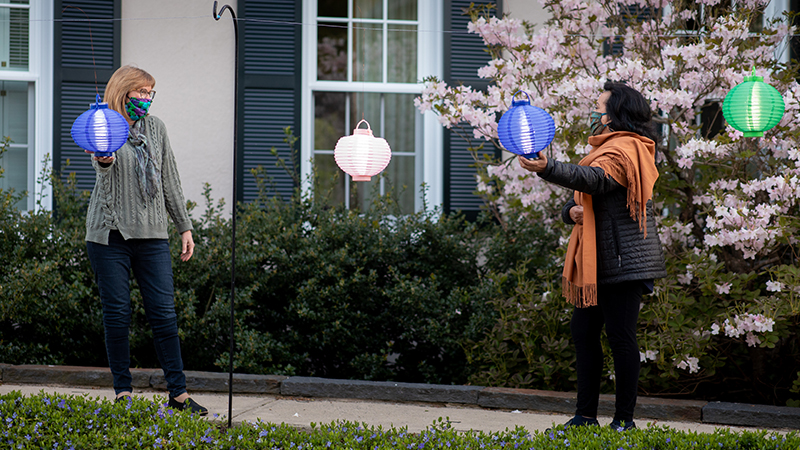Speeches & Media

Community in the Time of COVID-19
Our can-do spirit is sustained by connections to one another and to place.
Kathleen McCartney, Smith Alumnae Quarterly, Summer 2020
In mid-March, Smith, like most campuses, schools and workplaces, began to operate remotely. To slow the spread of the COVID-19 virus, most students returned to their families, faculty members began teaching remotely and employees—including me—largely began working from home. For an institution founded on, and devoted to, face-to-face education, this transition could have been a difficult pivot; for its entire history, Smith has provided an education that is intensely rooted in place. Our campus is purpose-built and intentionally developed for what we do best, namely teaching and learning in community. Within and beyond the classroom, it is a place where beauty makes deep claims on the heart and soul.
And yet, if there is a lesson of grace in this devastating pandemic, it is that our connections to one another can, when tested, transcend place. When necessary, and with shared spirit, we can teach and learn through a combination of virtual tools. We can carry on the college’s business through voice and video meetings. We can fulfill essential campus operations via dedicated teams in such areas as facilities and dining. With intention and creativity, we can build and sustain the inclusive community we aspire to be.
One of the transformations of which I am proudest is the way our faculty rose to the challenge of teaching remotely. They did so quickly and with a can-do spirit. In fact, many of them went beyond transferring their usual materials to virtual screens. Instead, they took advantage of the ways that digital teaching can transcend traditional media and boundaries.
For example, Professor of Dance Rodger Blum used video to teach movement classes, even inviting dance alums, as well as teachers from renowned dance centers like Jacob’s Pillow, to contribute to class discussions and help build students’ networks. Assistant Professor of Engineering Kris Dorsey taught her circuits class by setting up a lab in her home that students viewed via video. Assistant Professor of Biological Sciences Nathan Derr mailed Lego sets to students enrolled in Experimental Design in Bio-Molecular Engineering, so that they could build and display molecular models. Associate Professor of History Elizabeth Stordeur Pryor chose to focus on the COVID-19 pandemic itself in an advanced seminar in historical and archival research. Her students built an archive of the coronavirus pandemic at Smith to help future generations understand how the crisis unfolded.
If there is a lesson of grace in this devastating pandemic, it is that our connections can transcend place.
As at many colleges and universities, our pivot to remote instruction was not without early challenges. Some students and faculty members struggled at first with unfamiliar technologies and pedagogies; some reported difficulties with finding quiet space to work in homes where others were also working and learning. The deans and provost communicated frequently with students and faculty, connecting them to resources as needed.
Building on the “virtual classroom” experience, we prioritized the co-curricular and community-building opportunities that make the Smith experience so powerful. Vice President for Equity and Inclusion Floyd Cheung led an online discussion of the book Just Mercy: A Story of Justice and Redemption; author Bryan Stevenson’s planned visit to Smith this past spring had to be postponed, but I look forward to welcoming him to campus when it is safe to do so. Staff members in the counseling center offered virtual support groups for students of color, as well as for students dealing with social isolation and grief. Professor of English Language and Literature Ruth Ozeki ’80, a Zen Buddhist priest, hosted weekly guided online meditations. Many of these opportunities were open to alums, as well as to staff, faculty and students.
Alums, too, have played a vital part in building community. When our seniors grieved their displacement from campus and the cancelation of in-person Commencement activities, more than 250 alums sent generous messages of encouragement. Here are excerpts from a few messages that epitomize the generous, intergenerational support for which Smithies are rightly celebrated. “Be hopeful. We are fortunate to have one another.” “The enduring Smith connection is stronger than any pandemic.” “Remember that all the bonds you built with people are what make you a Smithie forever.” (See the story, page 80.)
As proud as I am of the resilience of this community, I have an equal conviction to the enduring power of residential education. A chemistry professor told me she attributes much of the success of this semester’s remote teaching to the connections forged on campus among students and faculty in the early weeks of the spring semester. Having shared classrooms, studios and labs together, students and teachers were able to translate pre-established bonds of trust and generosity to screen-mediated contexts.
While remote coursework has a useful place in higher education, there is little that can rival the transformative power of learning in place, in shared space, in community. I hope very much that conditions will allow us to safely welcome some students to campus this fall. We continue to plan toward that goal.
